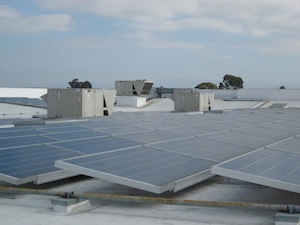City Council OK’s demo program to buy power from small-scale renewable generators

The Los Angeles Department of Water and Power (LADWP) now gets to ramp up a pilot phase that could add up to 150 megawatts of renewable electricity after 2016 — enough to power 22,000 homes — all with an eye toward hitting the state-mandated goal of 33% of its power from renewables by 2020. The measure awaits the mayor’s signature, expected late next week.
A common example of the new program would be a commercial real estate or large warehouse owner installing a rooftop solar power system and selling that power back to the local utility. The simplest definition I’ve found comes from another city that just approved a similar program for solar energy, Palo Alto: “Feed-in tariff programs involve a utility paying a fixed price, a “tariff,” for the power that is “fed into” their electric grid from local generation systems.”
The pros, cons and history of this trend, known as “distributed generation” or simply “DG,” are covered in plain language and plenty of colorful graphics in this presentation from the Department of Energy’s National Renewable Energy Laboratory (NREL). “FiT” programs, as they’re known, certainly aren’t as dramatic as acres of solar arrays stretched out across the Mojave but they offer two key advantages, according to LADWP’s presentation to the City Council and the NREL explainer:
- Proximity: if your local utility is receiving power from a source right inside its coverage area, then there are no expensive transmission lines to fund and string out over miles of possibly difficult terrain, like the 35 miles worth approved for Southern California Edison’s Ivanpah solar project near the Nevada border.
- Diversification: According to a Federal Energy Regulatory Commission (FERC) study, diversity can spell reliability: if all your “power” eggs aren’t in the same basket, then the chance of one power source’s problem taking out a huge swath of customers for a long period of time is less.
But that diversity can still be a disadvantage. Here’s why: our model for the past 100 years has been large power generating plants — mostly run with fossil fuels — sending electricity out to the grid and on to individual consumers. “Distributed” means the power is coming back the other way from a variety of sources in a variety of amounts at any given time of day — a whole lot trickier, given the need to constantly keep electrical generation and demand in balance. The power grid runs best on an even and constant supply of power. Solar is by nature intermittent, but even the technology to store solar-generated power is getting better all the time.
One other upside to solar power is that it is produced when it’s needed most: during daylight hours when most businesses are open and in the summer when people crank up their air conditioners. According to the FERC study, distributed generation can take some of the wear and tear off parts of the grid, reducing replacement costs and possibly avoiding a few more power failures along the way.
Just how big can distributed generation get in California? According to the 2010 California Clean Energy Future report, the state’s publicly owned utilities’ goal is to install 700 MW of distributed solar by 2017. Back in 2007, the California Energy Commission said it wanted distributed generation and co-generation built by utilities and others to meet 25% of the state’s peak load demand by 2020. Governor Jerry Brown aspires to 12,000 MW of “renewable distributed generation” by 2020. As of last year, the state had nearly 1,000 MW of customer-side distributed generation systems and another 2,200 MW from wholesale systems. UC Berkeley researchers recently issued a detailed roadmap for achieving that 12,000-MW goal. Its draft report calls for streamlining the permitting process at the state and local level; adopting a faster and less expensive utility interconnection process, and asks utilities to develop local geography-driven plans for integrating these new energy sources into the existing grid.
2 thoughts on “Green Light for Feed-in Tariff to Spark L.A. Renewable Energy”
Comments are closed.


It’s about time! The CURRENT power grid has trouble handling intermittent power flow. The answer is to update how the grid is operated, not stick with the status quo by building more transmission lines and perpetuating the monopoly big energy has over us.
Feed-in tarrifs should apply to ALL solar sources, including homeowners, not just commercial real estate or warehouse owners. This is how Germany & Spain became world leaders in renewable energy production over 10 years ago.
This is a step in the right direction and will prove we don’t need to decimate our wildlife habitats and agricultural lands by paving them over with industrial solar sites.
Thank you for reporting on this.
Kim and Matt, thank you both. What I remain curious about for Los Angeles is its political will to decide on a different course, and the bucks it would take to get there as we limp out of a recession. People at a different points on the spectrum would argue these baby steps are still giant leaps for a city still getting such a large percentage of its energy from out of state coal. Matt, thanks for the analogy about the Tesla running on Triple-A’s:-)